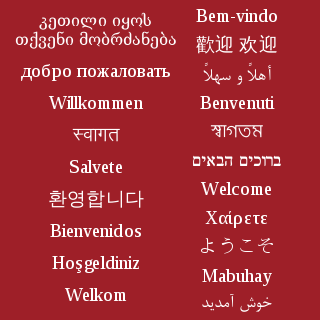
A salute is usually a formal hand gesture or other action used to display respect in military situations. Salutes are primarily associated with the military and law enforcement, but many civilian organizations, such as Girl Guides, Boy Scouts and the Salvation Army use formal salutes. Ordinary civilians also salute informally to greet or acknowledge the presence of another person, such as a tip of the hat or a hand wave to a friend or neighbour.
A musician is a person who composes, conducts, or performs music. According to the United States Employment Service, "musician" is a general term used to designate one who follows music as a profession. Musicians include songwriters who write both music and lyrics for songs, conductors who direct a musical performance, or performers who perform for an audience. A music performer is generally either a singer who provides vocals or an instrumentalist who plays a musical instrument. Musicians may perform on their own or as part of a group, band or orchestra. Musicians specialize in a musical style, and some musicians play in a variety of different styles depending on cultures and background. A musician who records and releases music can be known as a recording artist.

Greeting is an act of communication in which human beings intentionally make their presence known to each other, to show attention to, and to suggest a type of relationship or social status between individuals or groups of people coming in contact with each other. Greetings are sometimes used just prior to a conversation or to greet in passing, such as on a sidewalk or trail. While greeting customs are highly culture- and situation-specific and may change within a culture depending on social status and relationship, they exist in all known human cultures. Greetings can be expressed both audibly and physically, and often involve a combination of the two. This topic excludes military and ceremonial salutes but includes rituals other than gestures. A greeting, or salutation, can also be expressed in written communications, such as letters and emails.
The World War I Victory Medal was a United States service medal designed by James Earle Fraser of New York City under the direction of the Commission of Fine Arts.
The American Defense Service Medal was a military award of the United States Armed Forces, established by Executive Order 8808, by President Franklin D. Roosevelt, on June 28, 1941. The medal was intended to recognize those military service members who had served on active duty between September 8, 1939, and December 7, 1941.
The Navy Occupation Service Medal is a military award of the United States Navy which was "Awarded to commemorate the services of Navy, Marine Corps and Coast Guard personnel in the occupation of certain territories of the enemies of the United States during World War II" and recognized those personnel who participated in the European and Asian occupation forces during, and following World War II. The medal was also bestowed to personnel who performed duty in West Berlin between 1945 and 1990.
The Army of Occupation Medal is a military award of the United States military which was established by the United States War Department on 5 April 1946. The medal was created in the aftermath of the Second World War to recognize those who had performed occupation service in either Germany, Italy, Austria, Japan or Korea. The original Army of Occupation Medal was intended only for members of the United States Army, but was expanded in 1948 to encompass the United States Air Force shortly after that service's creation. The Navy and Marine equivalent of the Army of Occupation Medal is the Navy Occupation Service Medal, which features the same ribbon with its own medallion and clasps.
The NATO Medal is an international military decoration which is awarded to various militaries of the world under the authority of the North Atlantic Treaty Organization (NATO). It is manufactured by Eekelers-Centini Intl, of Hemiksem, Belgium.

The Seal of the Commonwealth of Kentucky was adopted in December 1792. Since that time, it has undergone several revisions. The current seal depicts two men, one in buckskin, and the other in more formal dress. The men are facing each other and clasping hands. The outer ring of the seal is adorned with the words "Commonwealth of Kentucky", and within the inner circle is the state motto "United we stand, divided we fall." The official colors of the seal are blue and gold. A version of the seal appears on the flag of Kentucky.

The Thai greeting referred to as the wai consists of a slight bow, with the palms pressed together in a prayer-like fashion. It has its origin in the Indian Añjali Mudrā, like the Indian namaste and Burmese mingalaba. The higher the hands are held in relation to the face and the lower the bow, the more respect or reverence the giver of the wai is showing. The wai is traditionally observed upon formally entering a house. After the visit is over, the visitor asks for permission to leave and repeats the salutation made upon entering. The wai is also common as a way to express gratitude or to apologise.

A medal bar or medal clasp is a thin metal bar attached to the ribbon of a military decoration, civil decoration, or other medal. It most commonly indicates the campaign or operation the recipient received the award for, and multiple bars on the same medal are used to indicate that the recipient has met the criteria for receiving the medal in multiple theatres.
Kira Hall is professor of Linguistics and Anthropology, as well as director for the Program in Culture, Language, and Social Practice (CLASP), at the University of Colorado at Boulder.

The fig sign is a mildly obscene gesture that uses a thumb wedged in between two fingers. The gesture is most commonly used to ward off the evil eye, insult someone, or deny a request. It has been used at least since the Roman Age in Southern Europe and parts of the Mediterranean region, including in Turkish culture. Some countries in Asia, Slavic cultures and South Africa use it too. It is used playfully in Northwestern Europe and countries such as the US, Canada, Australia, and Czech Republic to pretend to take the nose off a child.

Sembah is an Indonesian greeting and gesture as a way of demonstrating respect and reverence. While performing the sembah, the person clasped their palms together solemnly in a prayer-like fashion called suhun or susuhun in Javanese; or menyusun jari sepuluh in Indonesian and Malay, and placed them in front of the chest, and moving the combined palms up to the chin, or all the way up until the thumbs touching the tip of the nose, while bowing slightly. Any of these two forms are made depending on the status of the person greeted.

In humans, posture can provide a significant amount of important information through nonverbal communication. Psychological studies have also demonstrated the effects of body posture on emotions. This research can be traced back to Charles Darwin's studies of emotion and movement in humans and animals. Currently, many studies have shown that certain patterns of body movements are indicative of specific emotions. Researchers studied sign language and found that even non-sign language users can determine emotions from only hand movements. Another example is the fact that anger is characterized by forward whole body movement. The theories that guide research in this field are the self-validation or perception theory and the embodied emotion theory.

Namaste Tower is a 310 m (1,017 ft) tall skyscraper mega project in Mumbai, India. It would have been a mixed-use skyscraper with 63 floors that will house a 380-room W Hotel, office and retail space. It was designed by Atkins, Dubai. The design resembles the Namaste gesture: two wings of the hotel are clasped together like hands greeting.

Kul-e Farah is an archaeological site and open air sanctuary situated in the Zagros mountain valley of Izeh/Mālamir, in south-western Iran, around 800 meters over sea level. Six Elamite rock reliefs are located in a small gorge marked by a seasonal creek bed on the plain's east side of the valley, near the town of Izeh in Khuzestan.

Eshkaft-e Salman is an archaeological site in the Khuzestan province of Iran.

USS Blackford (APB-45) was a Benewah-class self-propelled barracks ship that was in service with the United States Navy during the waning days of World War II. She was decommissioned in April 1947 and sold for merchant service. In c. 1968-1970, she was sunk as a target by the South African Military.












